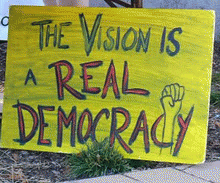The constitutional doctrines claiming "corporations are persons" and "money equals speech" and their effects are not the only fundamental threats to what remains of our democracy.[1] An additional and increasing assault is the U.S. Supreme Court itself -- not simply its decisions and their impact, but also its very structure.
Government 101 presents the Supreme Court as one of three branches of government (along with Congress and the President) that "checks and balances" each other. We've been conditioned to believe each branch is accountable to the others and ultimately to We the People -- resulting in the best democracy in the world.
It's true that Supreme decisions in recent times have asserted rights concerning gay marriage, just as in the past it asserted the civil rights of African American in the Deep South. Some Americans look to the Court, therefore, as champions of defending and expanding inalienable human rights that legislatures ignored or repressed.
But as David Cobb notes in a The Case for Judicial Review,[2] the Court's affirmation of civil rights of African Americans in the 1950's reversed the Court's oppression of African American decades earlier. Moreover, the Court decisions affirming minority rights often mirror growing social movements for those same rights. The history of U.S. judicial review is further detailed in Cobb's article.
TYRANTS OF AND FOR THE MINORITY
By contrast, the Court has been repeatedly guilty itself of being a tyrant of the minority (as in nine unelected judges reversing laws and regulations) and a tyrant for the minority (as in corporations and the super wealthy) by, for example, overturning 170 democratically enacted laws that protected workers, including children, during the early 20th century.
More recently, the Court has granted additional power and authority to corporations and the wealthy few. Supreme Court decisions weakened class action lawsuits against corporations, broadened the immunity protections of pharmaceutical corporations from suits over defective medications, heightened the barriers against workers who sue over workplace retaliation and harassment, increased the ability of commercial corporations to collect damages from municipalities that seek to impose conditions for building permits, and prohibited current US residents from suing Shell Oil corporation for human rights violations in Nigeria. Then, of course, there are the Citizens United, McCutcheon, and Hobby Lobby cases that further extended inalienable constitutional rights to corporations. Additional decisions provided the government greater leeway to conduct warrantless searches and seizures and overturned portions of the 1965 Voting Rights Act.
These anti-democratic decisions are possible because court justices are virtually completely unaccountable to the other branches of government and We the People. They've acquired supreme authority -- judicial review -- that gives them the power to review the actions of the executive and legislative branches to decide whether laws or regulations are constitutional. They are appointed for life. Their decisions cannot be overturned by legislation or Presidential decree. They are the Supremes, or "The Nine"[3] as Jeffrey Toobin calls them. Like Kings and Queens of old, they are virtual Sovereigns, nearly free from the democratizing promise of "checks and balances." Their insulation has been quite deliberate.
Not only are the Supremes untouchable, but their decisions are virtually unchangeable. The Constitution requires a herculean political effort to overturn a court decision by amendment. Two-thirds of both Houses of Congress must support an amendment or two-thirds of state legislatures must call for a Constitutional Convention where amendments can be agreed. Support by three-fourths of state legislatures is required in both instances for amendments to take effect. This anti-democratic high bar explains why the Constitution has been amended just 27 times, despite the many societal injustices demanding attention from the public and well-organized social movements.
It's no wonder the public dislikes the Court. Several recent polls rate the Court as overtly political. Sixty one percent of those polled think most Supremes have their own political agenda.[4] Another poll[5] indicates just 35% give the Supremes a positive job performance rating, a major decline from what was once perceived as one of the nation's more trusted institution. And this dissatisfaction crosses party lines, with Democrats giving the Court slightly higher marks than Republicans and Independents. On the Citizens United ruling alone, 84% Independents, 82% Democrats and 72% Republicans were opposed.
TINA
In regard to problem after problem and structural flaw after structural flaw, we're told time and again, "There is No Alternative" (TINA). Just accept unjust conditions as they are and go watch a sports contest or post what you ate for breakfast on Facebook.
But people are outraged. The veneer of the Supremes' objectivity has been shattered. The realization that citizens have near zero influence on the Court is causing people to explore alternatives and the means to bring them about. Efforts to overturn Supreme Court decisions via Constitutional Amendments, including the We the People Amendment proposed by Move to Amend, are varied and energetic. The issue of Judicial Review is being increasingly discussed and ways to "democratize" the Supremes are receiving more attention.
DEMOCRATIC STRUCTURAL ALTERNATIVES
Are there democratic alternatives to the current Supreme Court structure that might retain a degree of independence yet hold the Court accountable to the legislative and executive branches, as well as to We the People?
(Note: You can view every article as one long page if you sign up as an Advocate Member, or higher).






